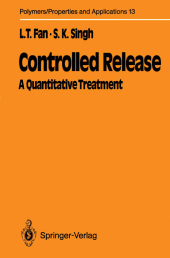 Neuerscheinungen 2012Stand: 2020-01-07 |
Schnellsuche
ISBN/Stichwort/Autor
|
Herderstraße 10
10625 Berlin
Tel.: 030 315 714 16
Fax 030 315 714 14
info@buchspektrum.de |

Liang-tseng Fan, Satish K. Singh
(Beteiligte)
Controlled Release
A Quantitative Treatment
Softcover reprint of the original 1st ed. 1989. 2012. x, 233 S. 7 Tabellen. 242 mm
Verlag/Jahr: SPRINGER, BERLIN 2012
ISBN: 3-642-74509-1 (3642745091)
Neue ISBN: 978-3-642-74509-6 (9783642745096)
Preis und Lieferzeit: Bitte klicken
The concept of controlled release has attracted increasing attention over the last two decades, with the applications of this technology proliferating in diverse fields in cluding medicine, agriculture and biotechnology. Research and developmental efforts related to controlled release are multiplying in both industry and academia. The reason for this phenomenal growth is obvious. The use of a variety of biologically active agents, such as drugs, fertilizers and pesticides, has become an integral part of modern society. Along with the use of these reagents has evolved an awareness that their uncontrolled application almost inevitably induces harmful effects on the health of humans and their surrounding environments. To eliminate or minimize these harmful effects necessitates the controlled release of these chemicals. Moreover, the controlled release of substances, not usually considered toxic or hazardous, e.g., some catalysts and nutrients, can enhance their effectiveness. The number and variety of controlled release systems, differing in their physical and chemical makeup, are increasing rapidly. Proliferation almost always demands correlation, generalization and unification; it requires both the development of underlying theories of their behavior and the mechanistic interpretation of their performance. This, in turn, requires a statistical and mathematical (quantitative) treatment of the scientific information and technical data pertaining to them. A quantitative treatment can also facilitate the formulation of procedures for computer-aided design of these systems through a priori prediction of their per formance for a variety of design parameters.
1 Introduction.- 1.1 Diffusion-Controlled Systems.- 1.1.1 Reservoir Devices.- 1.1.2 Monolithic Devices.- 1.2 Erosion or Chemical Reaction Controlled Systems.- 1.2.1 Erosion-Controlled Devices.- 1.2.2 Chemical Reaction Controlled Devices.- 1.3 Swelling-Controlled Release Systems.- 1.4 Osmotic Pumping Systems.- References.- 2 Diffusion-Controlled Release.- 2.1 Diffusion in Polymers.- 2.1.1 Estimation of Diffusion Coefficients.- 2.1.2 Factors Influencing Diffusional Release.- 2.2 Models for Diffusion-Controlled Release Systems.- 2.2.1 Reservoir Devices.- 2.2.2 Monolithic Devices.- 2.2.3 Porous Devices.- References.- 3 Chemical Reaction Controlled Release.- 3.1 Physically Immobilized Active Agent Systems.- 3.2 Chemically Immobilized Active Agent Systems.- 3.3 Models for Physically Immobilized Erosion-Activated Systems.- References.- 4 Swelling-Controlled Release.- 4.1 Penetrant Transport and the Polymer Relaxation Phenomena.- 4.1.1 Transport of Penetrants in Polymers.- 4.1.2 Models for Transport of Penetrants in Glassy Polymers.- 4.2 Active Agent Release from Swellable Polymers.- 4.3 Models for Swelling-Controlled Release Systems.- 4.3.1 One-Region Models.- 4.3.2 Two-Region Models.- References.- 5 Special Controlled-Release Systems.- 5.1 Osmotic Pumping Devices.- 5.2 Osmotically Activated Monolithic Devices.- 5.3 Externally Modulated Devices.- References.- 6 Stochastic Model for Diffusion in Porous or Heterogeneous Polymer Matrix.- 6.1 Derivation.- 6.1.1 Statistical Model for the Porous Heterogeneous-Polymer Matrix.- 6.1.2 State of the Diffusing Molecule and State Transitions.- 6.1.3 Derivation of the Master Equation.- 6.1.4 Recovery of the Diffusion Equation.- 6.2 Transport Coefficients from the Diffusion Equation.- 6.2.1 Mean or Effective Diffusion Coefficient.- 6.2.2 Drift or Convective Velocity.- 6.3 Transport Coefficients in Specific Systems.- 6.3.1 Mean or Effective Diffusion Coefficient.- 6.3.2 Drift or Convective Velocity.- 6.4 Monte Carlo Simulations of Transport in Porous Media.- 6.4.1 Procedure.- 6.4.2 Results.- 6.5 Concluding Remarks.- References.- Appendix 6A. Conversion of Probability to Number Concentration.- Appendix 6B. Derivation of Equation (6.39) from Equation (6.37).- Appendix 6C. Algorithm and FORTRAN Code for Monte Carlo Simulation of Transport in Porous Networks.- 7 Epilogue.- References.- Author Index.


